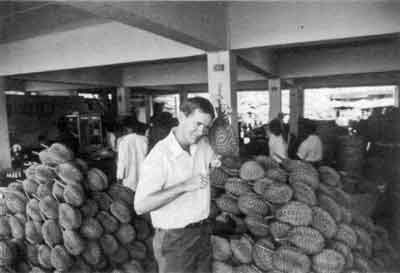
POST HARVEST DURIAN RESEARCH IN THAILAND
SCIENTIFIC NAME: Durio zibethinus
FAMILY: Bombacaceae
During a technical training visit to scientific institutions in Thailand April 1990, various observations were made on aspects of pre- and post-harvest Durian.
Thai researchers are concerned at this time with 2 major facets of Durian:
1. The determination of fruit maturity and subsequent eating quality.
2. The extension of 'green life' - to enable dry cargo export by ship to places such as Hong Kong (a 10-day trip).
It must be said that Thai people are the ultimate connoisseurs of Durian with specific expectations of varietal performance and preferences, even as to what appeals to older consumers and to the young - definitely an educated market. Eating is a serious business!
Maturity is a critical factor in determining the eating quality. Growers and researchers are currently working together to relate the number of days from full flowering (anthesis) - to eating quality and flavour attributes. Unfortunately, fruit maturity is affected by other factors such as crop load and even fruit position on a branch. Generally, fruit maturity increases toward the outside of the tree and heavy loads slow down fruit maturation. Perhaps this is reason for the existence of durian experts who gauge maturity on the farm by visual features and by tapping sounds from the fruit.
Varieties generally fall within certain maturity ranges of 'days from anthesis',
e.g. Gradoom-tong 90-95 + Days fully mature.
Chanee 100-105 + Days fully mature.
Varieties display certain latitudes of time to harvest from fully mature, where they will still ripen satisfactorily and reach a high eating quality. Under normal conditions. Gradoom-tong did not appear to have very much latitude in this way, while Chanee displayed a little more latitude.
Ripeness in Gradoom-tong was not related to the characteristic of stalk abscission, however Chanee does exhibit this attribute. Gradoom-tong displays a lightening in body colour of the fruit, while Chanee does not.
Fruit splitting was observed in fully mature Gradoom-tong fruit in just 48 hours after harvest at ambient temperatures of 30-35°C. Large splits exposed the aril segments of the fruit. Durian fruit pulp temperature was recorded to be 36°C when ambient temperatures were 32-33°C. This is the result of the heat generated by fruit respiration. Fruit segments can vary in degrees of ripeness within a fruit, often seen as differences in softness, and texture of the segment.
Green Life Extension Obviously in such a warm climate as Thailand (their hot season coinciding with fruit maturity), gains in postharvest life can be achieved by cooling fruit and even ripening at lower temperatures. Storage at twenty degrees gives significant gains in green life and fruit ripen acceptably. However, refrigeration is in short supply in Thailand and research there focuses on extension of green life at ambient temperatures by using fruit coatings such as waxes. Care needs to be taken with type, concentrations used, and fruit maturity to ensure success. Trial export shipments with fruit coatings have been carried out this year and commercial recommendations are being formulated. This may serve as a useful tool in Australia for southward-bound fruit from North Queensland as well.
Other observations in the field were made at the farm of Mr. Rabiab Krairit who owns a 60 rai farm (2.5 rai = 1 acre) in the Chantobouri province to the east of Bangkok (a 5-hour vehicle trip). Mr. Rabiab has been growing durian for 16 years and his large, heavily-cropped trees certainly made an impression on me.
The trees' branches were criss-crossed with ropes like a giant spider web to give structural support to the massive tree loads. Individual fruit were also tied up to prevent drop in some varieties. Recently Mr. Rabiab has been employing cultar sprays to boost yield even further. He mentioned the trees flush 2 - 3 times a year and he applies a foliar spray to the whole tree at first flush after harvest - unfortunately he was unable to remember the concentration. So seek local advice from Brian Watson, Kamerunga D.P.I.
 | Ian Wells tapping durians at the market |
DATE:September 1990
* * * * * * * * * * * * *
